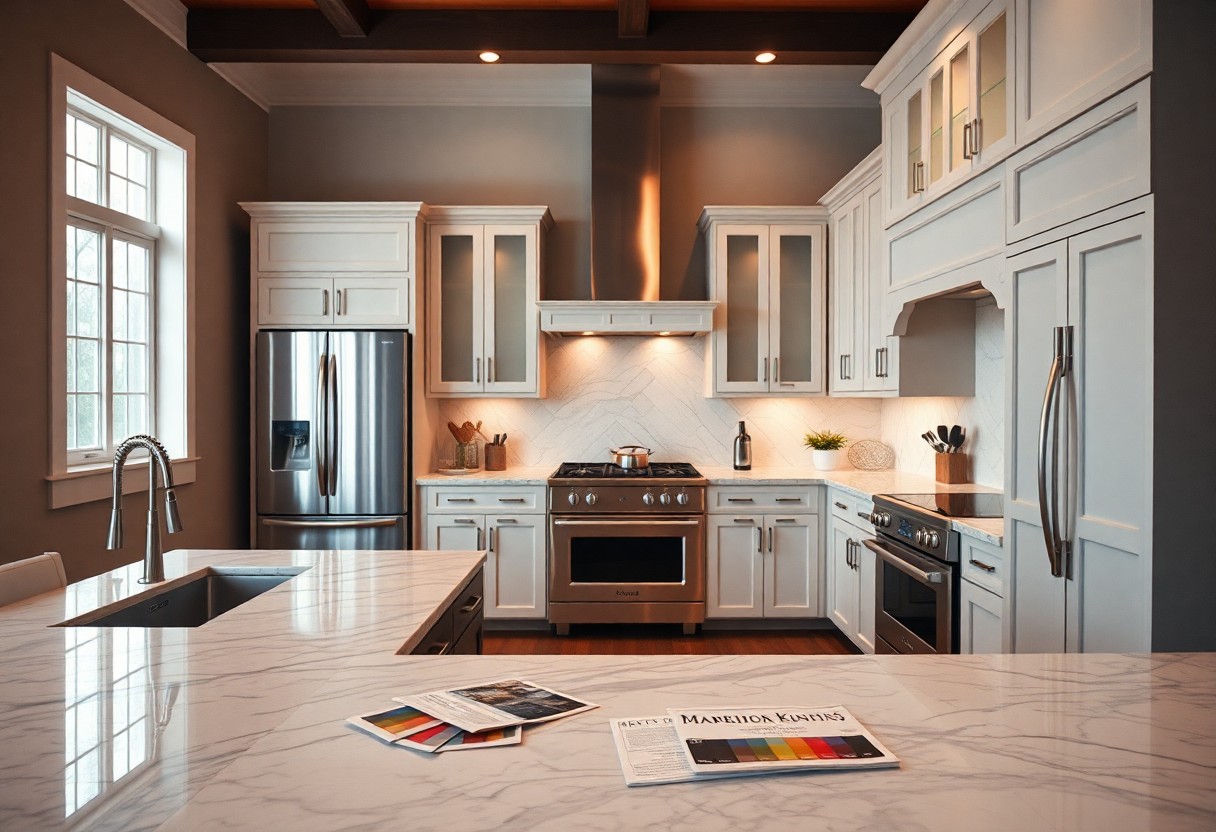Over the years, I have learned that planning a kitchen renovation involves careful thought and a strategic approach, especially for homeowners in Hamilton. You want a space that not only reflects your style but also meets your functional needs. In this post, I will guide you through vital considerations that will help you design your dream kitchen, ensuring you make informed decisions and avoid common pitfalls along the way.

Setting a Realistic Budget
The first step in planning your dream kitchen renovation is setting a realistic budget that aligns with your overall vision. I recommend outlining your priorities and establishing a clear spending limit to help you make informed decisions throughout the project. This budget should encompass materials, labor, and any additional features that enhance the functionality and aesthetics of your kitchen.
Determining Your Financial Limits
Any successful renovation begins with a thorough understanding of your financial boundaries. I suggest assessing your savings, potential loans, and any available grants. By considering your current financial situation and long-term objectives, you can create a design that not only meets your needs but also stays within your means.
Incorporating Unexpected Costs
Between materials, labor, and other planned expenses, it’s easy to overlook the additional costs that can arise during a kitchen renovation. I advise factoring in a buffer of 10-20% of your overall budget to cover unforeseen challenges, such as structural issues or supply delays.
Determining these unexpected costs early on will help you stay prepared for surprises that may arise during the renovation process. As I plan my own projects, I find that including this buffer allows me to address any necessary changes without drastically affecting my overall budget. By doing so, I can maintain peace of mind and focus on transforming my kitchen into the space I’ve always envisioned.
1. Define your budget before starting the renovation process.
2. Choose a layout that maximizes functionality and space.
3. Select durable materials for long-lasting performance.
4. Focus on energy-efficient appliances and fixtures.
5. Consider lighting options to enhance kitchen ambiance.
6. Plan for storage solutions to reduce clutter effectively.
Assessing Your Space
If you want your kitchen renovation to be successful, start by thoroughly assessing your space. Understanding the dimensions and layout of your kitchen is crucial in determining what changes are feasible while maximizing functionality. This evaluation will also help you establish a realistic budget and timeline for your project.
Measuring Dimensions
By measuring your kitchen’s dimensions accurately, you’ll gather vital information to aid in your renovation planning. Start with the length and width of your kitchen, including the height of the ceilings. Don’t forget to take into account doorways, windows, and fixed appliances, as these will influence your design options.
Evaluating Current Layout
At this stage, it’s important to evaluate your current kitchen layout. Assess how well the existing design meets your cooking and entertaining needs. Consider the work triangle formed by the stove, sink, and refrigerator, and identify any traffic flow issues that may be limiting your kitchen’s efficiency.
This evaluation not only highlights what’s working but also what can be improved upon. I typically recommend listing aspects of the layout you love and those you wish to change. By visualizing your ideal kitchen, you can create a more functional space that aligns with your lifestyle. Consider how you move through the kitchen while preparing meals, and think about incorporating features that enhance both efficiency and aesthetics.
Choosing the Right Style
For your kitchen renovation, selecting the right style is vital to achieving a space that reflects your personality and meets your functional needs. I recommend exploring various design elements, such as cabinetry, countertops, and lighting, to find a style that aligns with your vision. Your kitchen should seamlessly blend with the rest of your home while providing a welcoming atmosphere for family and friends.
Modern vs. Traditional Design
About kitchen styles, modern designs often feature sleek lines, minimalism, and a focus on efficiency, while traditional styles emphasize warmth, intricate details, and classic elements. I’ve found that the choice between modern and traditional can significantly impact the ambiance of your kitchen, so consider what resonates with you and your lifestyle.
Choosing Color Schemes and Materials
Style preferences play a major role in selecting colors and materials for your kitchen. I believe that the right palette can set the mood and define the overall character of the space. Think about how colors like soothing whites or bold blues can affect your kitchen’s vibe. Pairing these colors with materials like natural wood or polished granite can enhance the look and feel, making your kitchen not just functional but also visually appealing.
Right color schemes and materials can transform your kitchen into a stunning and cohesive space. I suggest creating a color palette that complements both your personal style and the architectural elements of your home. Consider finishes that are durable and easy to maintain, especially in high-traffic areas. Ultimately, the combination you choose should reflect both your aesthetic preferences and practical needs, ensuring a beautiful kitchen that withstands the test of time.
Prioritizing Functionality
To create the perfect kitchen, I always prioritize functionality above all else. Assessing how you cook and entertain can help in designing a space that meets your daily needs. Think about the layout, appliances, and features you require to ensure that everything is within easy reach and works harmoniously, making your kitchen a true haven for culinary creativity.
Kitchen Workflow Essentials
Behind every great kitchen is a well-planned workflow that makes cooking and meal preparation seamless. I find that focusing on the classic work triangle—comprising the stove, sink, and refrigerator—can significantly enhance efficiency. By ensuring these three key areas are close enough yet separate enough to avoid congestion, you can streamline your cooking process and create an enjoyable experience.
Storage Solutions
At the heart of a functional kitchen lies effective storage solutions. I believe that smart storage not only helps keep your kitchen organized but also maximizes usable space. Consider incorporating a mix of cabinets, drawers, and open shelving to accommodate your cooking imperatives, pantry items, and dishware, allowing you easy access while keeping countertops clutter-free.
Due to the range of utensils and appliances that often populate today’s kitchens, investing in custom storage solutions can make a noticeable difference. Features like pull-out shelves, corner cabinets with rotating organizers, and vertical dividers for baking sheets can enhance accessibility. Additionally, integrating multi-functional furniture, such as islands with built-in storage, provides both practical utility and style in your dream kitchen.
Selecting Appliances
Despite the overwhelming number of appliances available, choosing the right ones for your kitchen renovation can elevate both functionality and aesthetics. I recommend making a list of your cooking habits and preferences, which will help you narrow down options and select appliances that suit your lifestyle and budget.
Energy Efficiency Considerations
To ensure that your kitchen renovation is as sustainable as possible, pay attention to the energy efficiency ratings of the appliances you’re considering. I suggest looking for ENERGY STAR-certified options, as they can save you money on energy bills while reducing your environmental footprint.
Choosing the Right Brands and Models
By conducting thorough research on different brands and models, you can make informed decisions that align with your kitchen’s design and your budget. I find that reading customer reviews and expert opinions can guide me toward brands known for reliability and performance.
The variety of brands and models available can be daunting, but I focus on reputable manufacturers that offer warranties, customer service, and innovative features. It’s important to assess how well a specific model fits into your kitchen’s layout and design, as this can impact not just aesthetics but also usability. I encourage you to explore comparisons and get firsthand experiences from friends or family members who have used these appliances in their kitchens.
Hiring Professionals
Keep in mind that enlisting the help of professionals can make your kitchen renovation go smoothly. Skilled contractors and designers not only bring expertise but also guidance that can save you time and frustration. I recommend investing in a professional team that understands your vision and can help you navigate the complexities of your renovation project.
Finding the Right Contractor
Any homeowner knows that choosing the right contractor is vital for a successful kitchen renovation. I suggest gathering recommendations from friends or family and checking online reviews to identify trustworthy candidates. Interview potential contractors to discuss your vision, budget, and timelines, ensuring that they align with your expectations.
Understanding Permits and Regulations
To ensure your renovation is compliant, it’s vital to understand local permits and regulations. I advise checking with your local Hamilton municipality about necessary permits before commencing work, as this can prevent headaches down the line.
Consequently, understanding the requirements can save you time and money. It’s important to know which aspects of your renovation need permits—such as electrical or plumbing work—and to follow the city’s guidelines. If you’re unsure about the regulations, don’t hesitate to ask your contractor for help, as they’re usually familiar with the local rules. Navigating permits may seem tedious, but it can significantly impact the success of your renovation project.
Conclusion
With these considerations in mind, I believe you can effectively plan your dream kitchen renovation in Hamilton. By prioritizing functionality, budget, and style, you can create a space that reflects your personality and meets your needs. It’s important to research local regulations, collaborate with professionals, and select materials that not only enhance aesthetics but also offer durability. In the end, my goal is for you to enjoy a kitchen environment that truly feels like the heart of your home.


